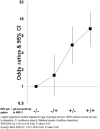Assessment of the Combined Effect of Epstein-Barr Virus and Plasmodium falciparum Infections on Endemic Burkitt Lymphoma Using a Multiplex Serological Approach
- PMID: 29123514
- PMCID: PMC5662586
- DOI: 10.3389/fimmu.2017.01284
Assessment of the Combined Effect of Epstein-Barr Virus and Plasmodium falciparum Infections on Endemic Burkitt Lymphoma Using a Multiplex Serological Approach
Abstract
Epstein-Barr virus (EBV) is a necessary cause of endemic Burkitt lymphoma (eBL), while the role of Plasmodium falciparum in eBL remains uncertain. This study aimed to generate new hypotheses on the interplay between both infections in the development of eBL by investigating the IgG and IgM profiles against several EBV and P. falciparum antigens. Serum samples collected in a childhood study in Malawi (2005-2006) from 442 HIV-seronegative children (271 eBL cases and 171 controls) between 1.4 and 15 years old were tested by quantitative suspension array technology against a newly developed multiplex panel combining 4 EBV antigens [Z Epstein-Barr replication activator protein (ZEBRA), early antigen-diffuse component (EA-D), EBV nuclear antigen 1, and viral capsid antigen p18 subunit (VCA-p18)] and 15 P. falciparum antigens selected for their immunogenicity, role in malaria pathogenesis, and presence in different parasite stages. Principal component analyses, multivariate logistic models, and elastic-net regressions were used. As expected, elevated levels of EBV IgG (especially against the lytic antigens ZEBRA, EA-D, and VCA-p18) were strongly associated with eBL [high vs low tertile odds ratio (OR) = 8.67, 95% confidence interval (CI) = 4.81-15.64]. Higher IgG responses to the merozoite surface protein 3 were observed in children with eBL compared with controls (OR = 1.29, 95% CI = 1.02-1.64), showing an additive interaction with EBV IgGs (OR = 10.6, 95% CI = 5.1-22.2, P = 0.05). Using elastic-net regression models, eBL serological profile was further characterized by lower IgM levels against P. falciparum preerythrocytic-stage antigen CelTOS and EBV lytic antigen VCA-p18 compared with controls. In a secondary analysis, abdominal Burkitt lymphoma had lower IgM to EBV and higher IgG to EA-D levels than cases with head involvement. Overall, this exploratory study confirmed the strong role of EBV in eBL and identified differential IgG and IgM patterns to erythrocytic vs preerythrocytic P. falciparum antigens that suggest a more persistent/chronic malaria exposure and a weaker IgM immune response in children with eBL compared with controls. Future studies should continue exploring how the malaria infection status and the immune response to P. falciparum interact with EBV infection in the development of eBL.
Keywords: Africa; Epstein–Barr virus; IgG; IgM; Plasmodium falciparum; children; endemic Burkitt lymphoma; multiplex.
Figures






Similar articles
-
Impact of Epstein-Barr virus co-infection on natural acquired Plasmodium vivax antibody response.PLoS Negl Trop Dis. 2022 Aug 3;16(8):e0010305. doi: 10.1371/journal.pntd.0010305. eCollection 2022 Aug. PLoS Negl Trop Dis. 2022. PMID: 35921373 Free PMC article.
-
Endemic Burkitt's lymphoma as a polymicrobial disease: new insights on the interaction between Plasmodium falciparum and Epstein-Barr virus.Semin Cancer Biol. 2009 Dec;19(6):411-20. doi: 10.1016/j.semcancer.2009.10.002. Epub 2009 Nov 6. Semin Cancer Biol. 2009. PMID: 19897039 Review.
-
The company malaria keeps: how co-infection with Epstein-Barr virus leads to endemic Burkitt lymphoma.Curr Opin Infect Dis. 2011 Oct;24(5):435-41. doi: 10.1097/QCO.0b013e328349ac4f. Curr Opin Infect Dis. 2011. PMID: 21885920 Free PMC article. Review.
-
Children with endemic Burkitt lymphoma are deficient in EBNA1-specific IFN-gamma T cell responses.Int J Cancer. 2009 Apr 1;124(7):1721-6. doi: 10.1002/ijc.24014. Int J Cancer. 2009. PMID: 19089927 Free PMC article.
-
The Association between the Comprehensive Epstein-Barr Virus Serologic Profile and Endemic Burkitt Lymphoma.Cancer Epidemiol Biomarkers Prev. 2020 Jan;29(1):57-62. doi: 10.1158/1055-9965.EPI-19-0551. Epub 2019 Oct 16. Cancer Epidemiol Biomarkers Prev. 2020. PMID: 31619404 Free PMC article.
Cited by
-
Impact of Epstein-Barr virus co-infection on natural acquired Plasmodium vivax antibody response.PLoS Negl Trop Dis. 2022 Aug 3;16(8):e0010305. doi: 10.1371/journal.pntd.0010305. eCollection 2022 Aug. PLoS Negl Trop Dis. 2022. PMID: 35921373 Free PMC article.
-
Malaria Infection and Risk for Endemic Burkitt Lymphoma: A Systematic Review and Meta-Analysis.Int J Environ Res Public Health. 2021 May 30;18(11):5886. doi: 10.3390/ijerph18115886. Int J Environ Res Public Health. 2021. PMID: 34070881 Free PMC article.
-
Development of quantitative suspension array assays for six immunoglobulin isotypes and subclasses to multiple Plasmodium falciparum antigens.J Immunol Methods. 2018 Apr;455:41-54. doi: 10.1016/j.jim.2018.01.009. Epub 2018 Jan 31. J Immunol Methods. 2018. PMID: 29397157 Free PMC article.
-
Validation of Multiplex Serology detecting human herpesviruses 1-5.PLoS One. 2018 Dec 27;13(12):e0209379. doi: 10.1371/journal.pone.0209379. eCollection 2018. PLoS One. 2018. PMID: 30589867 Free PMC article.
-
Optimization of incubation conditions of Plasmodium falciparum antibody multiplex assays to measure IgG, IgG1-4, IgM and IgE using standard and customized reference pools for sero-epidemiological and vaccine studies.Malar J. 2018 Jun 1;17(1):219. doi: 10.1186/s12936-018-2369-3. Malar J. 2018. PMID: 29859096 Free PMC article.
References
-
- IARC monographs on the evaluation of carcinogenic risks to humans. (2012) 100B Available from: http://monographs.iarc.fr/ENG/Monographs/vol100B/index.php - PMC - PubMed
-
- Olweny CL. Etiology of endemic Burkitt’s lymphoma. IARC Sci Publ (1984) 63:647–53. - PubMed
-
- Simone O, Bejarano MT, Pierce SK, Antonaci S, Wahlgren M, Troye-Blomberg M, et al. TLRs innate immunereceptors and Plasmodium falciparum erythrocyte membrane protein 1 (PfEMP1) CIDR1alpha-driven human polyclonal B-cell activation. Acta Trop (2011) 119(2–3):144–50.10.1016/j.actatropica.2011.05.005 - DOI - PMC - PubMed
LinkOut - more resources
Full Text Sources
Other Literature Sources
Research Materials

